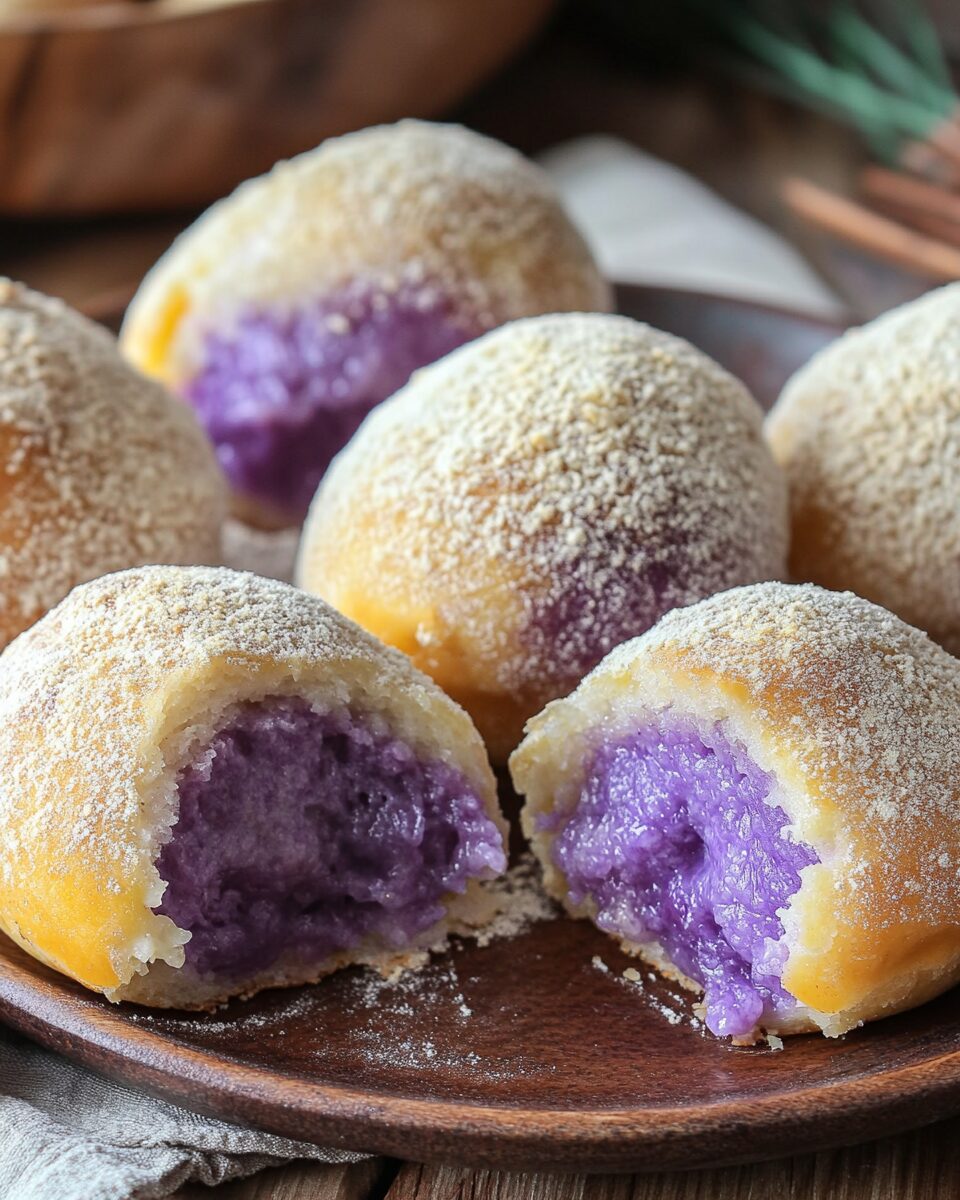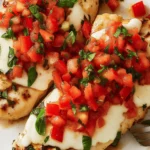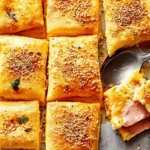Famous Filipino Ube Pandesal is a delightful Filipino bread roll that combines the creamy, sweet flavor of ube with the savory richness of cheese. These soft, fluffy buns are perfect for breakfast or as a snack, offering a unique twist on the traditional pandesal.
FULL RECIPE
Ingredients
- 2 cups all-purpose flour
- 1/4 cup ube jam (or ube halaya)
- 1/2 cup warm milk
- 1/4 cup sugar
- 1/4 cup butter, softened
- 1/2 teaspoon salt
- 2 teaspoons instant yeast
- 1 large egg
- 1/2 cup grated cheese (cheddar or queso de bola)
- 1/2 cup breadcrumbs (for coating)
- 1/4 cup water (adjust if needed)
Directions
- In a mixing bowl, combine flour, sugar, and salt. Add instant yeast and mix well.
- In a separate bowl, mix the warm milk, ube jam, and egg until smooth.
- Add the wet ingredients to the dry ingredients and knead until a dough forms.
- Add butter to the dough and continue kneading until smooth and elastic (about 8-10 minutes).
- Cover the dough with a clean towel and let it rise in a warm place for 1-2 hours, or until doubled in size.
- Punch down the dough and divide it into small portions. Flatten each portion slightly and place a small amount of grated cheese in the center.
- Fold the dough around the cheese and shape it into a ball. Roll each ball in breadcrumbs.
- Arrange the dough balls on a baking tray, leaving space between them, and let them rise for another 30 minutes.
- Preheat the oven to 350°F (175°C). Bake for 18-20 minutes or until golden brown.
- Allow the pandesal to cool slightly before serving.
Nutritional Information
- Calories: 150-200 per serving
- Protein: 4-5g
- Carbohydrates: 20-25g
- Fat: 6-8g
- Fiber: 1g
History of Pandesal
Pandesal, a traditional Filipino bread, has been a staple in Filipino households for centuries. It is often enjoyed with a cup of coffee or as a side dish to main meals. The word “pandesal” comes from the Spanish “pan de sal,” which means “salt bread.” Over time, the recipe evolved, becoming softer and sweeter, and it is now a popular breakfast item in the Philippines. Ube Cheese Pandesal is a modern twist on the classic pandesal, combining the flavors of the beloved ube (purple yam) and cheese, which has gained popularity for its distinct taste and vibrant color.
Cultural Significance of Ube in Filipino Cuisine
Ube, or purple yam, holds a special place in Filipino cuisine. Its bright purple color and sweet, nutty flavor make it a favorite ingredient for desserts. From ube halaya (sweet ube jam) to ube ice cream, this root vegetable has been used for generations in various Filipino dishes. In Ube Cheese Pandesal, the earthy taste of ube pairs beautifully with the savory cheese, offering a harmonious balance of flavors that is uniquely Filipino.
Ube and Cheese: A Perfect Pairing
The combination of ube and cheese might seem unusual at first, but it creates an incredible flavor profile. The sweetness of ube contrasts perfectly with the saltiness of cheese, creating a satisfying and well-rounded taste. The creamy texture of the ube filling complements the gooey, melted cheese, making each bite a delightful experience. This pairing is not only a hit in pandesal but also in other Filipino dishes like ube cheese ensaymada, further solidifying its place in Filipino culinary traditions.
The Role of Pandesal in Filipino Breakfast
Pandesal is an essential part of Filipino breakfast culture. It is commonly served with various spreads, such as butter, margarine, or cheese, and often paired with hot coffee or chocolate. It is a symbol of home and comfort, and for many Filipinos, it is the first meal of the day. Ube Cheese Pandesal adds an exciting variation to this breakfast tradition, making it even more flavorful and memorable.
Why Ube Cheese Pandesal Is a Crowd-Pleaser
Ube Cheese Pandesal has become a crowd favorite due to its delicious fusion of flavors and textures. The soft, fluffy bread has a slight sweetness from the ube, while the cheese adds a savory richness that creates a perfect balance. The addition of breadcrumbs gives the bread a slight crunch on the outside, adding another layer of texture that enhances the overall experience. This bread is suitable for a variety of occasions, from casual breakfasts to special celebrations.
The Science of Making Soft Pandesal
Achieving the perfect soft and fluffy pandesal involves a balance of ingredients and technique. The dough must be kneaded properly to develop gluten, which gives the bread its soft texture. Yeast plays a crucial role in the rising process, creating air pockets that contribute to the lightness of the bread. The addition of butter helps make the pandesal tender and moist, while the sugar contributes to the sweetness and helps the dough brown during baking. Ensuring that the dough is properly rested and allowed to rise will result in the signature softness that pandesal is known for.
The Importance of Using Fresh Yeast
Yeast is an essential ingredient in making fluffy pandesal. Fresh yeast helps the dough rise and become airy, creating a light and soft texture. Using expired or old yeast can result in flat, dense bread. It is crucial to check the expiration date on yeast packages and to use it while it is still fresh for the best results. Additionally, warm milk and water help activate the yeast, ensuring the dough rises properly.
Customizing Your Ube Cheese Pandesal
While the traditional Ube Cheese Pandesal is delicious on its own, you can also customize it to suit your preferences. Some people enjoy adding extra ingredients like raisins or other dried fruits to the dough. You can also experiment with different types of cheese, such as mozzarella or cream cheese, to achieve a different flavor and texture. Adding a sprinkle of sugar or drizzling condensed milk on top after baking can also enhance the sweetness of the bread.
Tips for Perfecting the Dough
Achieving the perfect dough for Ube Cheese Pandesal is all about consistency and technique. When mixing the ingredients, it is important to gradually add the wet ingredients to the dry ingredients to prevent overmixing. Kneading the dough until it is smooth and elastic is essential for developing the right texture. If the dough is too sticky, you can add a little more flour, but be careful not to add too much, as this can result in dense bread.
The Best Type of Cheese for Ube Cheese Pandesal
Cheese plays a significant role in the flavor of Ube Cheese Pandesal. While cheddar cheese is commonly used for its sharp flavor and melting qualities, you can experiment with other varieties. Queso de bola, a Filipino-style cheese made from edam, is another great choice for this recipe. It has a rich, slightly salty flavor that complements the sweetness of the ube filling. When selecting cheese, ensure it melts well to achieve the gooey texture inside the bread.
How to Store Ube Cheese Pandesal
To keep Ube Cheese Pandesal fresh, store it in an airtight container or wrap it tightly in plastic wrap. If you have leftover pandesal, you can also freeze it for future use. Simply wrap the bread individually in plastic wrap or foil and store it in a freezer-safe bag. To reheat, you can warm it in the oven for a few minutes to bring back its soft, fresh texture.
Serving Suggestions for Ube Cheese Pandesal
Ube Cheese Pandesal is delicious on its own, but it can also be paired with various sides and dips to enhance the flavor. You can serve it with a hot cup of Filipino coffee, hot chocolate, or a glass of fresh juice. For a more savory option, pair it with scrambled eggs, bacon, or sausage. The versatility of this bread makes it an excellent addition to breakfast, snacks, or even as an appetizer for gatherings.
The Growing Popularity of Ube Flavored Foods
The popularity of ube-flavored products has been on the rise in recent years. Ube is no longer limited to traditional Filipino desserts but has been incorporated into a wide range of foods, from ice cream to cakes, cookies, and even savory dishes. Ube’s striking purple color and its unique, sweet flavor make it an attractive and exciting ingredient to work with. Ube Cheese Pandesal is a perfect example of how Filipino flavors are being embraced and reinvented in modern cuisine.
Nutritional Benefits of Ube
Ube is not only delicious but also nutritious. It is a good source of vitamins and minerals, including vitamin C, potassium, and fiber. Ube is also known for its antioxidant properties, which help fight free radicals in the body. While Ube Cheese Pandesal is a treat that should be enjoyed in moderation, incorporating ube into your diet can provide various health benefits.
The Perfect Pairing of Sweet and Savory
Ube Cheese Pandesal showcases the delightful contrast between sweet and savory flavors. The sweetness of the ube filling balances perfectly with the saltiness of the cheese, creating a satisfying flavor profile that excites the taste buds. This combination has become a signature of Filipino fusion cuisine, where traditional flavors are merged to create new and exciting dishes.
How to Achieve the Perfect Golden Brown Crust
The key to achieving the perfect golden brown crust on your Ube Cheese Pandesal is to bake the bread at the right temperature. Preheat your oven to the recommended temperature (350°F or 175°C) to ensure that the bread bakes evenly. If you want an extra crispy crust, you can brush the tops of the dough with an egg wash before baking, which will give the bread a shiny, golden finish.
The Role of Butter in Ube Cheese Pandesal
Butter plays an important role in the texture and flavor of Ube Cheese Pandesal. It helps make the bread soft and tender, while also contributing to the richness of the dough. You can use unsalted butter to control the amount of salt in the bread or opt for salted butter for an added layer of flavor. Regardless of the type of butter, it should be softened to ensure it incorporates smoothly into the dough.
Serving Ube Cheese Pandesal at Special Occasions
Ube Cheese Pandesal is a great addition to any special occasion. Whether it’s a birthday, holiday, or family gathering, this bread will impress your guests with its unique flavor and beautiful color. It can be served alongside other Filipino favorites like lumpia, pancit, or leche flan for a complete Filipino feast. The vibrant purple color of the bread adds a festive touch to any table.
Ube Cheese Pandesal as a Gift
Ube Cheese Pandesal also makes a thoughtful and delicious gift. Whether it’s for a birthday, a holiday, or a special celebration, giving a batch of homemade Ube Cheese Pandesal shows effort and care. Pack them in a decorative box or basket for an extra touch of personalization. The unique combination of ube and cheese is sure to delight anyone who receives it.
Conclusion
Ube Cheese Pandesal has become a beloved treat that combines traditional Filipino flavors with a modern twist. Its soft, fluffy texture, paired with the rich, savory cheese and sweet ube, makes it an irresistible snack for any occasion. Whether you’re enjoying it for breakfast, as a snack, or at a special event, Ube Cheese Pandesal is sure to satisfy your taste buds. Its growing popularity speaks to the evolving Filipino food culture, where old favorites are reimagined to create something truly unique.






